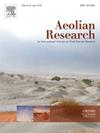火地岛大草原全新世风成沙丘-古土壤记录:巴塔哥尼亚最南端间冰期气候和环境变率的评估
IF 3.4
3区 地球科学
Q2 GEOGRAPHY, PHYSICAL
引用次数: 0
摘要
晚第四纪风成沙丘-古土壤沉积序列位于巴塔哥尼亚的火地岛北部,为了解南半球西风带南美洲最南端的全新世气候和环境变化提供了有价值的见解。利用与拉古纳阿图罗湖(53°43 ' S, 68°18 ' W)有关的短暂的浅沙丘的8个互层古土壤的形态和地球化学数据,我们评估了全新世的土壤形成。古土壤的形态特征和CIA指数表明,由于福建草原的半湿润气候,古土壤的水解和淋溶程度非常有限,风化程度较差。尽管如此,在晚冰期之后,成土作用导致了离散古土壤的形成。在该演替的晚全新世-早全新世和中全新世早期古土壤中,氧化作用是一个明显的过程。中全新世晚期古土壤较差的土壤学结构,以及风成沉积物的沉积速率,表明巴塔哥尼亚南部更有可能是干旱环境,这一模式与该地区其他多代理记录相一致。与中全新世相比,晚全新世古土壤的CIA指数和特征略高于中全新世。研究的沙丘-古土壤演替记录了相对较短的土壤形成间隔,这可能与大约12,800 cal年以来短期气候变化导致的福建草原湿度增加有关。BP,与南半球西风的动力学有关。本文章由计算机程序翻译,如有差异,请以英文原文为准。

Holocene aeolian dune-paleosol record at the Fuegian steppe: assessment of interglacial climate and environmental variability at the southernmost tip of Patagonia (Isla Grande de Tierra del Fuego)
Late Quaternary aeolian dune-paleosol sedimentary successions in perched dunes at the Fuegian steppe (northern Isla Grande de Tierra del Fuego, Patagonia) offer valuable insights into the Holocene climatic and environmental variability of southernmost South America, on the Southern Hemisphere westerly winds belt. Using morphological and geochemical data from eight paleosols interbedded in the aeolian units of a perched dune related to the ephemeral, shallow Laguna Arturo lake (53°43′ S, 68°18′ W), we assessed Holocene soil formation. The morphological characteristics and CIA index of the paleosols indicate poor to moderate weathering, with very limited hydrolysis and leaching mostly due to the subhumid climatic regime of the Fuegian steppe. Despite this, pedogenesis led to the formation of discrete paleosols after the Late Glacial. Oxidation is a conspicuous process in the Lateglacial-Early Holocene and early Middle Holocene paleosols of the succession. The poor pedological structure of paleosols from the late Middle Holocene, along with the aeolian deposits rate of sedimentation, records more likely arid conditions in southern Patagonia, a pattern consistent with other multi-proxy records in the region. The Late Holocene paleosols record slightly higher CIA indices and characteristics compatible with a higher moisture in the environment compared to the Middle Holocene. The studied dune-paleosol succession documents relatively short soil formation intervals, possibly linked to increased humidity in the Fuegian steppe due to short-term climate variability since around 12,800 cal yrs. BP, related to the dynamics of the Southern Hemisphere westerly winds.
求助全文
通过发布文献求助,成功后即可免费获取论文全文。
去求助
来源期刊

Aeolian Research
GEOGRAPHY, PHYSICAL-
CiteScore
7.10
自引率
6.10%
发文量
43
审稿时长
>12 weeks
期刊介绍:
The scope of Aeolian Research includes the following topics:
• Fundamental Aeolian processes, including sand and dust entrainment, transport and deposition of sediment
• Modeling and field studies of Aeolian processes
• Instrumentation/measurement in the field and lab
• Practical applications including environmental impacts and erosion control
• Aeolian landforms, geomorphology and paleoenvironments
• Dust-atmosphere/cloud interactions.
 求助内容:
求助内容: 应助结果提醒方式:
应助结果提醒方式:


